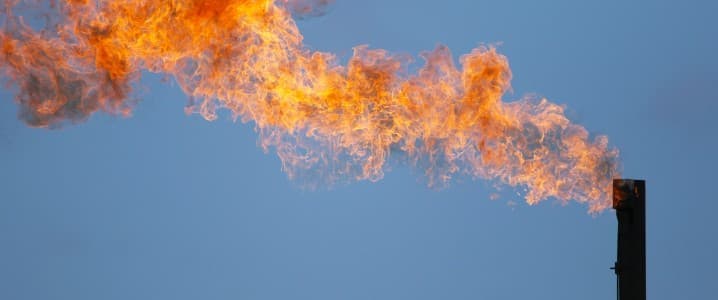The idea that an oil or gas pipeline could be positive news for the environment is completely alien to those who believe we should put an end to the fossil fuel era once and for all. Yet if you ask someone who happened to be close when two oil trains in Canada derailed recently about their opinion, they might disagree about the pipelines.
The disagreement could be even sharper when gas pipelines are concerned, because more gas pipelines mean less gas flaring.
Gas flaring is the practice of burning associated gas that comes out of an oil well with the oil. In 2018, the shale boom drove the amount of gas flared in the United States up 48 percent, and the global total up 3 percent to 145 billion cubic meters, according to data from the World Bank.
But flaring means emissions, so that’s a rise in emissions, too—a rise necessitated to a large extent by the lack of adequate gas transportation and storage infrastructure.
But this is changing: Kinder Morgan just got cleared by a court to build a 2-billion-cu-ft pipeline that will carry natural gas from the Permian to Houston. That’s 2 billion cu ft of gas that will not be flared. From an environmentalist point of view, the pipeline should be, if not good, then at least a lesser evil than the alternative.
Yet the construction of the pipeline is not yet guaranteed. The project was challenged in court on the grounds that it would affect wildlife in the area where it will pass, including some endangered species. Last week, a district judge in Austin rejected the opponents’ request for a temporary restraining order on the grounds that they had failed to provide sufficient proof of the negative effect the pipeline would have on local wildlife. Related: Chinese Refinery Run Rates Fall To 6-Year Low
Yet opponents have vowed to continue fighting, The Houston Chronicle’s Sergio Chapa reported this week. They will be fighting against the perceived environmental impact of the pipeline on local wildlife and against eminent domain legislation that allowed Kinder Morgan to buy land for the pipeline, angering some landowners.
“The final routing decision should be made by public officials accountable to all the citizens of Texas,” said the executive director of an advocacy group representing the landowners suing the pipeline operator. “Kinder Morgan executives should not have the unilateral power to decide where to build an industrial highway that affects thousands of landowners and dozens of communities.”
The issue seems like it will be settled in court in yet another round of the decades-long match between landowners and pipeline builders. The wildlife issue seems to have been settled by Kinder Morgan agreeing to buy a ranch to replace the part of an endangered songbird’s habitat that the pipeline route will pass through.
In all of this, the flaring debate seems pushed to the background—but it should be the focus of attention.
Last year, during the first quarter, gas flaring in the Permian reached a record-high of over 660 million cu ft daily. According to the World Bank, total global gas flaring stands at around 140 billion cubic meters annually. This translates into some 200 million cubic meters of carbon dioxide. Two billion cu ft is equal to around 57 million cubic meters: that’s a sizeable portion of the global total that will not be flared, reducing CO2 emissions substantially enough to matter.
While there is more than one reason for various stakeholders to oppose an oil or gas pipeline project, including the zeitgeist, flaring is drawing more attention from the industry, and this is good news. Related: Three Innovations To Upend The Energy Storage Market
Occidental Petroleum, for instance, just became the first U.S. company to join the World Bank’s Zero Routine Flaring initiative, committing to end all routine flaring at its wells by 2030. Pioneer Natural Resources, EOG Resources, Conoco, and Chesapeake Energy, for their part, were recently named top performers in gas flaring in Texas by a state energy regulator. At the other end of the scale, the worst performers were led by Endeavor Energy Resources, Surge Operating, and Jagged Peak Energy.
The industry is definitely on board with reducing flaring. After all, flared gas is wasted gas. and even in the current depressed price situation for natural gas, it’s better to store it than to burn it. Burning it doesn’t just emit carbon dioxide: that’s the best-case scenario.
ADVERTISEMENT
To flare what some call waste gas and other associated gas, companies add natural gas to help it burn, and steam. If the mixture of gas and steam is not just right, the process of flaring could lead to the release of methane, propane, and other constituent gases of what we collectively call natural gas, which are more harmful than CO2. Reducing flaring will reduce these emissions, too.
That’s why environmental activists should welcome the Permian Highway. It will reduce flaring in one of the United States’ biggest oil-producing regions where companies focus on the oil and have little interest in the gas, so they burn it. Land acquisition disputes aside, it might be worth weighing the small risk of the pipeline route crossing the golden-cheeked warbler habitat (it will affect less than 1 percent of the habitat, says the U.S. Fish and Wildlife Service) against the 2 billion cu ft of gas that will not be flared thanks to the pipeline.
By Irina Slav for Oilprice.com
More Top Reads From Oilprice.com:
- Oil Suppliers Slash Prices To Save Asian Market Share
- Can LNG Kill Oil?
- What Will Oil Prices Do After The Coronavirus?


















